EMD算法的matlab程序介绍
matlab使用经验模式分解emd对信号进行去噪

matlab使⽤经验模式分解emd对信号进⾏去噪:对于这个例⼦,考虑由具有明显频率变化的正弦波组成的⾮平稳连续信号。
⼿提钻的振动或烟花声是⾮平稳连续信号的例⼦。
以采样频率加载⾮平稳信号数据fs,并可视化混合正弦信号。
1.load('sinusoidalSignalExampleData.mat','X','fs');2.3.xlabel('Time(s)');观察到混合信号包含具有不同幅度和频率值的正弦波。
为了创建希尔伯特谱图,您需要信号的IMF。
执⾏经验模式分解以计算信号的固有模式函数和残差。
由于信号不平滑,请指定' pchip'作为Interpolation⽅法。
[imf,residual,info] = emd(X,'Interpolation','pchip');1.⽬前的IMF | #Sift Iter | 相对Tol | 停⽌标准命中2.1 |2 | 0.026352 | SiftMaxRelativeTolerance3.2 | 2 | 0.0039573 | SiftMaxRelativeTolerance4.3 | 1 | 0.024838 | SiftMaxRelativeTolerance5.4 | 2 | 0.05929 | SiftMaxRelativeTolerance6.5 | 2 | 0.11317 | SiftMaxRelativeTolerance7.6 | 2 | 0.12599 | SiftMaxRelativeTolerance8.7 | 2 | 0.13802 | SiftMaxRelativeTolerance9.8 | 3 | 0.15937 | SiftMaxRelativeTolerance10.9 | 2 | 0.15923 | SiftMaxRelativeTolerance11.分解停⽌是因为残留信号的极值数⼩于'MaxNumExtrema'。
EMD与EEMD程序

%%%%%%%%%%%载入信号x=load('1.txt');%产生信号N=length(x);%采样点数fs=2000;%采样频率dt=1/fs;%采样时间间隔t=(0:N-1)*dt;%产生时间序列%%%%%%%%EMDimf=emd(x);%EMD.M(EMD程序)%G.Rilling,July2002%%computesEMD(EmpiricalModeDecomposition)accordingto:%%N.E.Huangetal.,"Theempiricalmodedecompositionandthe%Hilbertspectrumfornon-linearandnonstationarytimeseriesanalysis,"%Proc.RoyalSoc.LondonA,Vol.454,pp.903-995,1998%%withvariationsreportedin:%%G.Rilling,P.FlandrinandP.Gon?alvès %"OnEmpiricalModeDecompositionanditsalgorithms"%IEEE-EURASIPWorkshoponNonlinearSignalandImageProcessing%NSIP-03,Grado(I),June2003%%stoppingcriterionforsifting:%ateachpoint:meanamplitude<threshold2*envelopeamplitude%&%meanofbooleanarray((meanamplitude)/(envelopeamplitude)>threshold)<tolerance %&%|#zeros-#extrema|<=1%%inputs:-x:analysedsignal(linevector)%-t(optional):samplingtimes(linevector)(default:1:length(x))%-stop(optional):threshold,threshold2andtolerance(optional)%forsiftingstoppingcriterion%default:[0.05,0.5,0.05]%-tst(optional):ifequalsto1showssiftingstepswithpause%ifequalsto2nopause%%outputs:-imf:intrinsicmodefunctions(lastline=residual)%-ort:indexoforthogonality%-nbits:numberofiterationsforeachmode%%calls:-extr(findsextremaandzero-crossings)%-io:computestheindexoforthogonalityfunction[imf,ort,nbits]=emd(x,t,stop,tst);%defaultforstoppingdefstop=[0.05,0.5,0.05];if(nargin==1)t=1:length(x);stop=defstop;tst=0;endif(nargin==2)stop=defstop;tst=0;endif(nargin==3)tst=0;endS=size(x);if((S(1)>1)&(S(2)>1))|(length(S)>2)error('xmusthaveonlyoneroworonecolumn')endif S(1)>1x=x';endS=size(t);if((S(1)>1)&(S(2)>1))|(length(S)>2)error('tmusthaveonlyoneroworonecolumn')endif S(1)>1t=t';endif(length(t)~=length(x))error('xandtmusthavethesamelength')endS=size(stop);if((S(1)>1)&(S(2)>1))|(S(1)>3)|(S(2)>3)|(length(S)>2)error('stopmusthaveonlyoneroworonecolumnofmaxthreeelements') endif S(1)>1stop=stop';S=size(stop);endif S(2)<3stop(3)=defstop(3);endif S(2)<2stop(2)=defstop(2);endsd=stop(1);sd2=stop(2);tol=stop(3);if tstfigureend%maximumnumberofiterationsMAXITERATIONS=2000;%maximumnumberofsymmetrizedpointsforinterpolationsNBSYM=2;lx=length(x);sdt(lx)=0;sdt=sdt+sd;sd2t(lx)=0;sd2t=sd2t+sd2;%maximumnumberofextremaandzero-crossingsinresidualner=lx;nzr=lx;r=x;imf=[];k=1;%iterationscounterforextractionof1modenbit=0;%totaliterationscounterNbIt=0;while ner>2%currentmodem=r;%modeatpreviousiterationmp=m;sx=sd+1;%testsifenoughextrematoproceedtest=0;[indmin,indmax,indzer]=extr(m);lm=length(indmin);lM=length(indmax);nem=lm+lM;nzm=length(indzer);j=1;%siftingloopwhile(mean(sx>sd)>tol|any(sx>sd2)|(abs(nzm-nem)>1))&(test==0)&nbit<MAXITERATIONS if(nbit>MAXITERATIONS/5&mod(nbit,floor(MAXITERATIONS/10))==0)disp(['mode',int2str(k),'nombrediterations:',int2str(nbit)])disp(['stopparametermeanvalue:',num2str(s)])end%boundaryconditionsforinterpolations:if indmax(1)<indmin(1)if m(1)>m(indmin(1))lmax=fliplr(indmax(2:min(end,NBSYM+1)));lmin=fliplr(indmin(1:min(end,NBSYM)));lsym=indmax(1);elselmax=fliplr(indmax(1:min(end,NBSYM)));lmin=[fliplr(indmin(1:min(end,NBSYM-1))),1];lsym=1;endelseif m(1)<m(indmax(1))lmax=fliplr(indmax(1:min(end,NBSYM)));lmin=fliplr(indmin(2:min(end,NBSYM+1)));lsym=indmin(1);elselmax=[fliplr(indmax(1:min(end,NBSYM-1))),1];lmin=fliplr(indmin(1:min(end,NBSYM)));lsym=1;endendif indmax(end)<indmin(end)if m(end)<m(indmax(end))rmax=fliplr(indmax(max(end-NBSYM+1,1):end));rmin=fliplr(indmin(max(end-NBSYM,1):end-1));rsym=indmin(end);elsermax=[lx,fliplr(indmax(max(end-NBSYM+2,1):end))]; rmin=fliplr(indmin(max(end-NBSYM+1,1):end));rsym=lx;endelseif m(end)>m(indmin(end))rmax=fliplr(indmax(max(end-NBSYM,1):end-1));rmin=fliplr(indmin(max(end-NBSYM+1,1):end));rsym=indmax(end);elsermax=fliplr(indmax(max(end-NBSYM+1,1):end));rmin=[lx,fliplr(indmin(max(end-NBSYM+2,1):end))]; rsym=lx;endendtlmin=2*t(lsym)-t(lmin);tlmax=2*t(lsym)-t(lmax);trmin=2*t(rsym)-t(rmin);trmax=2*t(rsym)-t(rmax);%incasesymmetrizedpartsdonotextendenoughif tlmin(1)>t(1)|tlmax(1)>t(1)if lsym==indmax(1)lmax=fliplr(indmax(1:min(end,NBSYM)));elselmin=fliplr(indmin(1:min(end,NBSYM)));endif lsym==1error('bug')endlsym=1;tlmin=2*t(lsym)-t(lmin);tlmax=2*t(lsym)-t(lmax);endif trmin(end)<t(lx)|trmax(end)<t(lx)if rsym==indmax(end)rmax=fliplr(indmax(max(end-NBSYM+1,1):end));elsermin=fliplr(indmin(max(end-NBSYM+1,1):end));endif rsym==lxerror('bug')endrsym=lx;trmin=2*t(rsym)-t(rmin);trmax=2*t(rsym)-t(rmax);endmlmax=m(lmax);mlmin=m(lmin);mrmax=m(rmax);mrmin=m(rmin);%definitionofenvelopesfrominterpolationenvmax=interp1([tlmaxt(indmax)trmax],[mlmaxm(indmax)mrmax],t,'spline'); envmin=interp1([tlmint(indmin)trmin],[mlminm(indmin)mrmin],t,'spline'); envmoy=(envmax+envmin)/2;m=m-envmoy;[indmin,indmax,indzer]=extr(m);lm=length(indmin);lM=length(indmax);nem=lm+lM;nzm=length(indzer);%evaluationofmeanzerosx=2*(abs(envmoy))./(abs(envmax-envmin));s=mean(sx);%displayif tstsubplot(4,1,1)plot(t,mp);hold on;plot(t,envmax,'--k');plot(t,envmin,'--k');plot(t,envmoy,'r');title(['IMF',int2str(k),';iteration',int2str(nbit),'beforesifting']);set(gca,'XTick',[])hold offsubplot(4,1,2)plot(t,sx)hold onplot(t,sdt,'--r')plot(t,sd2t,':k')title('stopparameter')set(gca,'XTick',[])hold offsubplot(4,1,3)plot(t,m)title(['IMF',int2str(k),';iteration',int2str(nbit),'aftersifting']);set(gca,'XTick',[])subplot(4,1,4);plot(t,r-m)title('residue');disp(['stopparametermeanvalue:',num2str(s)])if tst==2pause(0.01)elsepauseendend%endloop:stopsifnotenoughextremaif nem<3test=1;endmp=m;nbit=nbit+1;NbIt=NbIt+1;if(nbit==(MAXITERATIONS-1))warning(['forcedstopofsifting:toomanyiterations...mode',int2str(k),'.stopparametermea nvalue:',num2str(s)])endendimf(k,:)=m;if tstdisp(['mode',int2str(k),'enregistre'])nbits(k)=nbit;k=k+1;r=r-m;[indmin,indmax,indzer]=extr(r);ner=length(indmin)+length(indmax);nzr=length(indzer);nbit=1;if(max(r)-min(r))<(1e-10)*(max(x)-min(x))if ner>2warning('forcedstopofEMD:toosmallamplitude')elsedisp('forcedstopofEMD:toosmallamplitude')endbreakendendimf(k,:)=r;ort=io(x,imf);if tstcloseendEEMD程序%ThisisanEMD/EEMDprogram%%functionallmode=eemd(Y,Nstd,NE)%%INPUT:%Y:Inputteddata;(输入数据)%Nstd:ratioofthestandarddeviationoftheaddednoiseandthatofY;(添加噪声和Y的标准偏差的比率)%NE:EnsemblenumberfortheEEMD(EEMD集合的数量)%OUTPUT:%AmatrixofN*(m+1)matrix,whereNisthelengthoftheinput%dataY,andm=fix(log2(N))-1.Column1istheoriginaldata,columns2,3,...(一个N*(m+1)矩阵,其中N是输入数据Y的长度,和m=fix(log2(N))-1。
emd算法仿真 光谱数据去噪

emd算法仿真光谱数据去噪电磁脉冲(EMD)算法(Empirical Mode Decomposition)是一种用于信号处理的自适应时频分析方法,它可以将信号分解为若干个固有模态函数(Intrinsic Mode Functions,IMFs)。
EMD 在信号去噪中有一定的应用,但直接应用于光谱数据去噪可能需要考虑一些特定的问题。
以下是一个使用 Python 中的 EMD 算法库 PyEMD 对光谱数据进行去噪的示例:首先,确保你已经安装了 PyEMD 库。
你可以使用以下命令进行安装:pip install EMD-signal然后,使用下面的 Python 代码演示如何在光谱数据上应用 EMD 进行去噪:import numpy as npimport matplotlib.pyplot as pltfrom PyEMD import EMD# 生成一些示例光谱数据np.random.seed(42)x = np.linspace(0, 10, 1000)spectrum_data = np.sin(x) + 0.2 * np.random.randn(1000)# 使用 EMD 进行信号分解emd = EMD()IMFs = emd(spectrum_data)# 选择保留的 IMFs(去噪效果可能取决于保留的 IMFs 数量)selected_IMFs = [1, 2, 3] # 根据实际情况选择保留的 IMFs denoised_spectrum = np.sum(IMFs[selected_IMFs], axis=0)# 绘制原始光谱和去噪后的光谱plt.figure(figsize=(10, 6))plt.subplot(2, 1, 1)plt.plot(x, spectrum_data, label='Original Spectrum')plt.title('Original Spectrum')plt.subplot(2, 1, 2)plt.plot(x, denoised_spectrum, label='Denoised Spectrum', color='orange')plt.title('Denoised Spectrum')plt.tight_layout()plt.show()这个示例中,我们使用PyEMD 库中的EMD 类来对光谱数据进行信号分解,然后选择一些IMFs(固有模态函数)来重构去噪后的光谱。
matlab中的ceemd函数

MATLAB (Matrix Laboratory) 是一种用于算法开发、数据可视化、数据分析和数值计算的高级技术计算语言和交互式环境。
它是MATLAB公司MathWorks的主要产品之一,被广泛应用于工程、科学和数学等领域。
CEEMD (Complete Ensemble Empirical Mode Dposition) 是一种数据分解方法,用于分解非平稳和非线性数据,以揭示数据中的潜在信息。
在MATLAB中,CEEMD可以通过CEEMD 函数来实现。
本文将介绍MATLAB中的CEEMD函数的基本原理、用法和实际应用。
1. CEEMD函数的基本原理CEEMD是一种基于经验模态分解 (EMD) 的数据分解方法,它通过将原始信号分解成一组本征模态函数 (EMD) 和残差的方法来揭示信号内部的结构特征。
CEEMD函数首先对原始信号进行一系列轮次的随机取样和平滑处理,然后将这些处理后的信号进行集成,得到最终的本征模态函数和残差。
这种方法可以有效地处理非线性和非平稳数据,并且不需要对数据进行先验的假设,因此在各种领域都有广泛的应用。
2. CEEMD函数的用法在MATLAB中,CEEMD函数的用法非常简单。
用户需要将原始信号传入CEEMD函数,并设置一些参数,如轮次、随机取样次数等。
CEEMD函数会自动进行数据分解,并输出本征模态函数和残差。
用户可以根据实际需求对输出的结果进行进一步的分析和处理,如提取特征、去噪等。
3. CEEMD函数的实际应用CEEMD函数在实际应用中有着广泛的应用。
在信号处理领域,CEEMD函数可以用于处理非平稳和非线性信号,如地震信号、生物信号等。
在金融领域,CEEMD函数可以用于分解股票价格的波动,揭示其内在的规律。
在医学领域,CEEMD函数可以用于分析医学图像和生物信号,帮助医生进行诊断和治疗。
MATLAB中的CEEMD函数是一种强大的数据分解工具,它可以帮助用户从非平稳和非线性数据中提取有用的信息,广泛应用于工程、科学、金融和医学等领域。
二维数据bemd分解matlab

一、概述在科学研究和工程应用中,二维数据分析和处理是非常常见的问题。
其中,bemd分解(Bivariate Empirical Mode Dposition)是一种用于对二维数据进行分解的有效方法。
在本文中,我们将重点介绍如何使用Matlab工具进行二维数据的bemd分解,以及该方法在实际应用中的意义和作用。
二、二维数据bemd分解的原理和方法bemd是一种基于经验模态分解(Empirical Mode Dposition,简称EMD)的技术,在处理二维数据时是非常有用的。
该方法的基本原理是将二维数据分解为一系列二维本征模态函数(Intrinsic Mode Function,简称IMF),从而实现数据的局部化分析和处理。
在进行bemd分解时,通常会使用Hilbert-Huang变换来进行辅助处理,以确保得到的IMF函数具有较好的时频局部性质。
三、Matlab工具在二维数据bemd分解中的应用Matlab是一种广泛应用于科学计算和数据分析的工具,它提供了丰富的函数库和工具包,可以方便地进行各种数据处理和分析。
在进行二维数据bemd分解时,我们可以借助Matlab中的相关函数和工具来实现较为高效的计算和分析。
通过调用Matlab中的emd、hilbert等函数,可以很容易地实现二维数据的bemd分解。
四、二维数据bemd分解在实际应用中的意义和作用二维数据bemd分解在实际应用中有着广泛的意义和作用。
在信号处理领域中,bemd分解可以用于对图像、声音等二维信号进行分析和处理,从而提取出其中的局部特征和信息。
在地震学、气象学等领域中,bemd分解也可以用于对地震波形、气象数据等二维空时信号进行处理,以便进行地震监测、气象预测等工作。
五、结论通过本文的介绍,我们了解了二维数据bemd分解的原理和方法,以及在Matlab中进行bemd分解的具体步骤和技术。
我们还深入探讨了bemd分解在实际应用中的意义和作用。
EMD信号处理方法在LabVIEW和MATLAB中的实现

LabV IEW 设计用户图形界面 ,负责数据采集和网络 通信 ;由 MATLAB 在后台提供算法供 LabV IEW 调 用。
1 基于 EMD 的信号处理方法
基于模态分解的时频分析方法于 1998 年由美 国国家宇航局的 Norden E. Huang提出 ,他是运用基 于经验的模态分解方法 ,将一个时间序列信号分解 成有限个不同时间尺度的内禀模态函数 IMF ( intrin2 sic mode function) ,然后将每个 IM F 进行 H ilbert Huang变换 ,得到时频平面上的能量分布谱图 ,用来 分析信号时频谱特征的信号分析方法 。 H ilbert Huang变换适合处理非线性 、非平稳信号 。用这种 方法进行分析可更准确有效地掌握原信号的特征信 息 。此方法包括两个过程 :经验模态分解和 H ilbert 变换 ,其中最关键的部分是 EMD 方法 。 EMD 方法 基于信号的局部特征时间尺度 ,能把复杂信号函数 分解为有限的内禀模态函数之和 ,每一个 IM F所包 含的频率成分不仅与分析频率有关 ,而且最重要的 是随信号本身变化而变化 ,因此 , EMD 方法是自适 应的信号处理方法 。 1. 1 EMD 基本理论
(完整word版)EM算法matlab程序
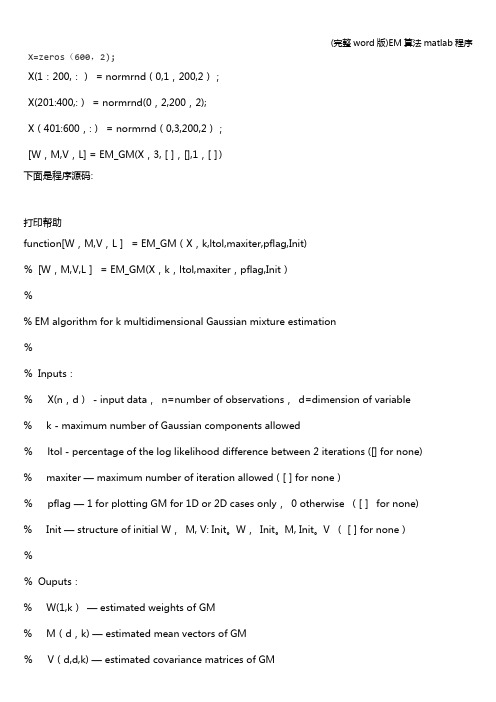
X=zeros(600,2);X(1:200,:)= normrnd(0,1,200,2);X(201:400,:)= normrnd(0,2,200,2);X(401:600,:)= normrnd(0,3,200,2);[W,M,V,L] = EM_GM(X,3,[],[],1,[])下面是程序源码:打印帮助function[W,M,V,L]= EM_GM(X,k,ltol,maxiter,pflag,Init)%[W,M,V,L]= EM_GM(X,k,ltol,maxiter,pflag,Init)%% EM algorithm for k multidimensional Gaussian mixture estimation%%Inputs:%X(n,d)- input data,n=number of observations,d=dimension of variable % k - maximum number of Gaussian components allowed%ltol - percentage of the log likelihood difference between 2 iterations ([] for none) % maxiter — maximum number of iteration allowed ([] for none)%pflag — 1 for plotting GM for 1D or 2D cases only,0 otherwise ([]for none) % Init — structure of initial W,M, V: Init。
W,Init。
M, Init。
V ([] for none)%%Ouputs:% W(1,k)— estimated weights of GM% M(d,k) — estimated mean vectors of GM%V(d,d,k) — estimated covariance matrices of GM%L — log likelihood of estimates%%Written by%Patrick P。
MATLAB之经验模态分解EMD
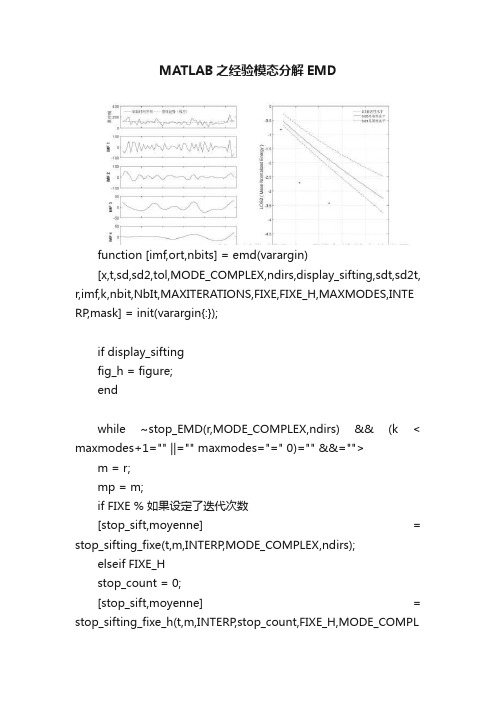
MATLAB之经验模态分解EMDfunction [imf,ort,nbits] = emd(varargin)[x,t,sd,sd2,tol,MODE_COMPLEX,ndirs,display_sifting,sdt,sd2t, r,imf,k,nbit,NbIt,MAXITERATIONS,FIXE,FIXE_H,MAXMODES,INTE RP,mask] = init(varargin{:});if display_siftingfig_h = figure;endwhile ~stop_EMD(r,MODE_COMPLEX,ndirs) && (k < maxmodes+1="" ||="" maxmodes="=" 0)="" &&=""> m = r;mp = m;if FIXE % 如果设定了迭代次数[stop_sift,moyenne] = stop_sifting_fixe(t,m,INTERP,MODE_COMPLEX,ndirs);elseif FIXE_Hstop_count = 0;[stop_sift,moyenne] = stop_sifting_fixe_h(t,m,INTERP,stop_count,FIXE_H,MODE_COMPLEX,ndirs);else[stop_sift,moyenne] = stop_sifting(m,t,sd,sd2,tol,INTERP,MODE_COMPLEX,ndirs);endif (max(abs(m))) <>if ~stop_siftwarning('emd:warning','forced stop of EMD : too small amplitude')elsedisp('forced stop of EMD : too small amplitude')endbreakendwhile ~stop_sift && nbit<>if(~MODE_COMPLEX && nbit>MAXITERATIONS/5 && mod(nbit,floor(MAXITERATIONS/10))==0 && ~FIXE && nbit > 100)disp(['mode ',int2str(k),', iteration ',int2str(nbit)])if exist('s','var')disp(['stop parameter mean value : ',num2str(s)])end[im,iM] = extr(m);disp([int2str(sum(m(im) > 0)),' minima > 0; ',int2str(sum(m(iM) < 0)),'="" maxima=""><>endm = m - moyenne;if FIXE[stop_sift,moyenne] =stop_sifting_fixe(t,m,INTERP,MODE_COMPLEX,ndirs);elseif FIXE_H[stop_sift,moyenne,stop_count] = stop_sifting_fixe_h(t,m,INTERP,stop_count,FIXE_H,MODE_COMPL EX,ndirs);else[stop_sift,moyenne,s] = stop_sifting(m,t,sd,sd2,tol,INTERP,MODE_COMPLEX,ndirs);endif display_sifting && ~MODE_COMPLEXNBSYM = 2;[indmin,indmax] = extr(mp);[tmin,tmax,mmin,mmax] = boundary_conditions(indmin,indmax,t,mp,mp,NBSYM);envminp = interp1(tmin,mmin,t,INTERP);envmaxp = interp1(tmax,mmax,t,INTERP);envmoyp = (envminp+envmaxp)/2;if FIXE || FIXE_Hdisplay_emd_fixe(t,m,mp,r,envminp,envmaxp,envmoyp,nbit, k,display_sifting)elsesxp = 2*(abs(envmoyp))./(abs(envmaxp-envminp));sp = mean(sxp);display_emd(t,m,mp,r,envminp,envmaxp,envmoyp,s,sp,sxp,s dt,sd2t,nbit,k,display_sifting,stop_sift)endendmp = m;nbit = nbit+1;NbIt = NbIt+1;if (nbit==(MAXITERATIONS-1) && ~FIXE && nbit > 100)if exist('s','var')warning('emd:warning',['forced stop of sifting : too many iterations... mode ',int2str(k),'. stop parameter mean value : ',num2str(s)])elsewarning('emd:warning',['forced stop of sifting : too many iterations... mode ',int2str(k),'.'])endendendimf(k,:) = m;if display_siftingdisp(['mode ',int2str(k),' stored'])endnbits(k) = nbit;k = k+1;r = r - m;nbit = 0;endif any(r) && ~any(mask)imf(k,:) = r;endort = io(x,imf);if display_siftingcloseendendfunction stop = stop_EMD(r,MODE_COMPLEX,ndirs)if MODE_COMPLEXfor k = 1:ndirsphi = (k-1)*pi/ndirs;[indmin,indmax] = extr(real(exp(i*phi)*r));ner(k) = length(indmin) + length(indmax);endstop = any(ner <>else[indmin,indmax] = extr(r);ner = length(indmin) + length(indmax);stop = ner <>endendfunction [envmoy,nem,nzm,amp] = mean_and_amplitude(m,t,INTERP,MODE_COMPLEX,ndirs) NBSYM = 2;if MODE_COMPLEXswitch MODE_COMPLEXcase 1for k = 1:ndirsphi = (k-1)*pi/ndirs;y = real(exp(-i*phi)*m);nem(k) = length(indmin)+length(indmax);nzm(k) = length(indzer);[tmin,tmax,zmin,zmax] = boundary_conditions(indmin,indmax,t,y,m,NBSYM);envmin(k,:) = interp1(tmin,zmin,t,INTERP);envmax(k,:) = interp1(tmax,zmax,t,INTERP);endenvmoy = mean((envmin+envmax)/2,1);if nargout > 3amp = mean(abs(envmax-envmin),1)/2;endcase 2for k = 1:ndirsphi = (k-1)*pi/ndirs;y = real(exp(-i*phi)*m);[indmin,indmax,indzer] = extr(y);nem(k) = length(indmin)+length(indmax);nzm(k) = length(indzer);[tmin,tmax,zmin,zmax] = boundary_conditions(indmin,indmax,t,y,y,NBSYM);envmin(k,:) = exp(i*phi)*interp1(tmin,zmin,t,INTERP);envmax(k,:) = exp(i*phi)*interp1(tmax,zmax,t,INTERP);endenvmoy = mean((envmin+envmax),1);if nargout > 3amp = mean(abs(envmax-envmin),1)/2;endendelsenem = length(indmin)+length(indmax);nzm = length(indzer);[tmin,tmax,mmin,mmax] = boundary_conditions(indmin,indmax,t,m,m,NBSYM);envmin = interp1(tmin,mmin,t,INTERP);envmax = interp1(tmax,mmax,t,INTERP);envmoy = (envmin+envmax)/2;if nargout > 3amp = mean(abs(envmax-envmin),1)/2; % 计算包络幅度endendendfunction [stop,envmoy,s] = stop_sifting(m,t,sd,sd2,tol,INTERP,MODE_COMPLEX,ndirs) try[envmoy,nem,nzm,amp] = mean_and_amplitude(m,t,INTERP,MODE_COMPLEX,ndirs);sx = abs(envmoy)./amp;s = mean(sx);stop = ~((mean(sx > sd) > tol | any(sx > sd2)) & (all(nem > 2)));if ~MODE_COMPLEXstop = stop && ~(abs(nzm-nem)>1);endcatchstop = 1;envmoy = zeros(1,length(m));s = NaN;endendfunction [stop,moyenne]= stop_sifting_fixe(t,m,INTERP,MODE_COMPLEX,ndirs)trymoyenne = mean_and_amplitude(m,t,INTERP,MODE_COMPLEX,ndirs);stop = 0;catchmoyenne = zeros(1,length(m));stop = 1;endendfunction [stop,moyenne,stop_count]= stop_sifting_fixe_h(t,m,INTERP,stop_count,FIXE_H,MODE_COMPL EX,ndirs)try[moyenne,nem,nzm] = mean_and_amplitude(m,t,INTERP,MODE_COMPLEX,ndirs);if (all(abs(nzm-nem)>1))stop = 0;stop_count = 0;elsestop_count = stop_count+1;stop = (stop_count == FIXE_H);endcatchmoyenne = zeros(1,length(m));stop = 1;endendfunctiondisplay_emd(t,m,mp,r,envmin,envmax,envmoy,s,sb,sx,sdt,sd2t,nb it,k,display_sifting,stop_sift)subplot(4,1,1)plot(t,mp);hold on;plot(t,envmax,'--k');plot(t,envmin,'--k');plot(t,envmoy,'r');title(['IMF ',int2str(k),'; iteration ',int2str(nbit),' before sifting']);set(gca,'XTick',[])hold offsubplot(4,1,2)plot(t,sx)hold onplot(t,sdt,'--r')plot(t,sd2t,':k')title('stop parameter')set(gca,'XTick',[])hold offsubplot(4,1,3)plot(t,m)title(['IMF ',int2str(k),'; iteration ',int2str(nbit),' after sifting']);set(gca,'XTick',[])subplot(4,1,4);plot(t,r-m)title('residue');disp(['stop parameter mean value : ',num2str(sb),' before sifting and ',num2str(s),' after'])if stop_siftdisp('last iteration for this mode')endif display_sifting == 2pause(0.01)elsepauseendendfunctiondisplay_emd_fixe(t,m,mp,r,envmin,envmax,envmoy,nbit,k,display _sifting)subplot(3,1,1)plot(t,mp);hold on;plot(t,envmax,'--k');plot(t,envmin,'--k');plot(t,envmoy,'r');title(['IMF ',int2str(k),'; iteration ',int2str(nbit),' before sifting']);set(gca,'XTick',[])hold offsubplot(3,1,2)plot(t,m)title(['IMF ',int2str(k),'; iteration ',int2str(nbit),' after sifting']);set(gca,'XTick',[])subplot(3,1,3);plot(t,r-m)title('residue');if display_sifting == 2pause(0.01)elsepauseendendfunction [tmin,tmax,zmin,zmax] = boundary_conditions(indmin,indmax,t,x,z,nbsym)% 实数情况下,x = zlx = length(x);% 判断极值点个数if (length(indmin) + length(indmax) <>error('not enough extrema')end% 插值的边界条件if indmax(1) <> % 第一个极值点是极大值if x(1) > x(indmin(1)) % 以第一个极大值为对称中心lmax = fliplr(indmax(2:min(end,nbsym+1)));lmin = fliplr(indmin(1:min(end,nbsym)));lsym = indmax(1);else % 如果第一个采样值小于第一个极小值,则将认为该值是一个极小值,以该点为对称中心lmax = fliplr(indmax(1:min(end,nbsym)));lmin = [fliplr(indmin(1:min(end,nbsym-1))),1];lsym = 1;endelseif x(1) <> % 以第一个极小值为对称中心lmax = fliplr(indmax(1:min(end,nbsym)));lmin = fliplr(indmin(2:min(end,nbsym+1)));lsym = indmin(1);else % 如果第一个采样值大于第一个极大值,则将认为该值是一个极大值,以该点为对称中心lmax = [fliplr(indmax(1:min(end,nbsym-1))),1];lmin = fliplr(indmin(1:min(end,nbsym)));lsym = 1;endend% 序列末尾情况与序列开头类似if indmax(end) <>if x(end) <>rmax = fliplr(indmax(max(end-nbsym+1,1):end));rmin = fliplr(indmin(max(end-nbsym,1):end-1));rsym = indmin(end);elsermax = [lx,fliplr(indmax(max(end-nbsym+2,1):end))];rmin = fliplr(indmin(max(end-nbsym+1,1):end));rsym = lx;endelseif x(end) > x(indmin(end))rmax = fliplr(indmax(max(end-nbsym,1):end-1));rmin = fliplr(indmin(max(end-nbsym+1,1):end));rsym = indmax(end);elsermax = fliplr(indmax(max(end-nbsym+1,1):end));rmin = [lx,fliplr(indmin(max(end-nbsym+2,1):end))];rsym = lx;endend% 将序列根据对称中心,镜像到两边tlmin = 2*t(lsym)-t(lmin);tlmax = 2*t(lsym)-t(lmax);trmin = 2*t(rsym)-t(rmin);trmax = 2*t(rsym)-t(rmax);% 如果对称的部分没有足够的极值点if tlmin(1) > t(1) || tlmax(1) > t(1) % 对折后的序列没有超出原序列的范围if lsym == indmax(1)lmax = fliplr(indmax(1:min(end,nbsym)));elselmin = fliplr(indmin(1:min(end,nbsym)));endif lsym == 1 % 这种情况不应该出现,程序直接中止error('bug')endlsym = 1; % 直接关于第一采样点取镜像tlmin = 2*t(lsym)-t(lmin);tlmax = 2*t(lsym)-t(lmax);end% 序列末尾情况与序列开头类似if trmin(end) < t(lx)="" ||="" trmax(end)=""><> if rsym == indmax(end)rmax = fliplr(indmax(max(end-nbsym+1,1):end)); elsermin = fliplr(indmin(max(end-nbsym+1,1):end)); endif rsym == lxerror('bug')endrsym = lx;trmin = 2*t(rsym)-t(rmin);trmax = 2*t(rsym)-t(rmax);end% 延拓点上的取值zlmax = z(lmax);zlmin = z(lmin);zrmax = z(rmax);zrmin = z(rmin);% 完成延拓tmin = [tlmin t(indmin) trmin];tmax = [tlmax t(indmax) trmax];zmin = [zlmin z(indmin) zrmin];zmax = [zlmax z(indmax) zrmax];end%---------------------------------------------------------------------------------------------------% 极值点和过零点位置提取function [indmin, indmax, indzer] = extr(x,t)if(nargin==1)t = 1:length(x);endm = length(x);if nargout > 2x1 = x(1:m-1);x2 = x(2:m);indzer = find(x1.*x2<> % 寻找信号符号发生变化的位置if any(x == 0) % 考虑信号采样点恰好为0的位置iz = find( x==0 ); % 信号采样点恰好为0的位置indz = [];if any(diff(iz)==1) % 出现连0的情况zer = x == 0; % x=0处为1,其它地方为0dz = diff([0 zer 0]); % 寻找0与非0的过渡点debz = find(dz == 1); % 0值起点finz = find(dz == -1)-1; % 0值终点indz = round((debz+finz)/2); % 选择中间点作为过零点elseindz = iz; % 若没有连0的情况,该点本身就是过零点endindzer = sort([indzer indz]); % 全体过零点排序end% 提取极值点d = diff(x);n = length(d);d1 = d(1:n-1);d2 = d(2:n);indmin = find(d1.*d2<0 &="">0><> % 最小值indmax = find(d1.*d2<0 &="" d1="">0)+1; % 最大值% 当连续多个采样值相同时,把最中间的一个值作为极值点,处理方式与连0类似if any(d==0)imax = [];imin = [];bad = (d==0);dd = diff([0 bad 0]);debs = find(dd == 1);fins = find(dd == -1);if debs(1) == 1 % 连续值出现在序列开头if length(debs) > 1debs = debs(2:end);fins = fins(2:end);elsedebs = [];fins = [];endif length(debs) > 0if fins(end) == m % 连续值出现在序列末尾if length(debs) > 1debs = debs(1:(end-1));fins = fins(1:(end-1));elsedebs = [];fins = [];endendendlc = length(debs);if lc > 0for k = 1:lcif d(debs(k)-1) > 0 % 取中间值if d(fins(k)) <>imax = [imax round((fins(k)+debs(k))/2)]; endelseif d(fins(k)) > 0imin = [imin round((fins(k)+debs(k))/2)]; endendendendif length(imax) > 0indmax = sort([indmax imax]);if length(imin) > 0indmin = sort([indmin imin]);endendend%---------------------------------------------------------------------------------------------------function ort = io(x,imf)% ort = IO(x,imf) 计算正交指数%% 输入 : - x : 分析信号% - imf : IMF信号n = size(imf,1);s = 0;% 根据公式计算for i = 1:nfor j = 1:nif i ~= js = s + abs(sum(imf(i,:).*conj(imf(j,:)))/sum(x.^2));endendendort = 0.5*s;end%---------------------------------------------------------------------------------------------------% 函数参数解析function[x,t,sd,sd2,tol,MODE_COMPLEX,ndirs,display_sifting,sdt,sd2t,r,im f,k,nbit,NbIt,MAXITERATIONS,FIXE,FIXE_H,MAXMODES,INTERP,m ask] = init(varargin)x = varargin{1};if nargin == 2if isstruct(varargin{2})inopts = varargin{2};elseerror('when using 2 arguments the first one is the analyzed signal X and the second one is a struct object describing the options')endelseif nargin > 2tryinopts = struct(varargin{2:end});catcherror('bad argument syntax')endend% 默认停止条件defstop = [0.05,0.5,0.05];opt_fields = {'t','stop','display','maxiterations','fix','maxmodes','interp','fix_h',' mask','ndirs','complex_version'};% 时间序列,停止参数,是否演示,最大迭代次数,每一轮迭代次数,IMF个数,插值方法,每一轮迭代次数(带条件),mask信号,方向数,是否采用复数模式defopts.stop = defstop;defopts.display = 0;defopts.t = 1:max(size(x));defopts.maxiterations = 2000;defopts.fix = 0;defopts.maxmodes = 0;defopts.interp = 'spline';defopts.fix_h = 0;defopts.mask = 0;defopts.ndirs = 4;plex_version = 2;opts = defopts;if(nargin==1)inopts = defopts;elseif nargin == 0error('not enough arguments')endnames = fieldnames(inopts);for nom = names'if ~any(strcmpi(char(nom), opt_fields))error(['bad option field name: ',char(nom)])endif ~isempty(eval(['inopts.',char(nom)]))eval(['opts.',lower(char(nom)),' = inopts.',char(nom),';'])endendt = opts.t;stop = opts.stop;display_sifting = opts.display;MAXITERATIONS = opts.maxiterations;FIXE = opts.fix;MAXMODES = opts.maxmodes;INTERP = opts.interp;FIXE_H = opts.fix_h;mask = opts.mask;ndirs = opts.ndirs;complex_version = plex_version;if ~isvector(x)error('X must have only one row or one column')endif size(x,1) > 1x = x.';endif ~isvector(t)error('option field T must have only one row or one column')if ~isreal(t)error('time instants T must be a real vector')endif size(t,1) > 1t = t';endif (length(t)~=length(x))error('X and option field T must have the same length')endif ~isvector(stop) || length(stop) > 3error('option field STOP must have only one row or one column of max three elements')endif ~all(isfinite(x))error('data elements must be finite')endif size(stop,1) > 1stop = stop';endL = length(stop);if L <>stop(3) = defstop(3);if L <>stop(2) = defstop(2);endif ~ischar(INTERP) || ~any(strcmpi(INTERP,{'linear','cubic','spline'}))error('INTERP field must be ''linear'', ''cubic'', ''pchip'' or ''spline''')end% 使用mask信号时的特殊处理if any(mask)if ~isvector(mask) || length(mask) ~= length(x)error('masking signal must have the same dimension as the analyzed signal X')endif size(mask,1) > 1mask = mask.';endopts.mask = 0;imf1 = emd(x+mask, opts);imf2 = emd(x-mask, opts);if size(imf1,1) ~= size(imf2,1)warning('emd:warning',['the two sets of IMFs have different sizes: ',int2str(size(imf1,1)),' and ',int2str(size(imf2,1)),' IMFs.']) endS1 = size(imf1,1);S2 = size(imf2,1);if S1 ~= S2 % 如果两个信号分解得到的IMF个数不一致,调整顺序if S1 <>tmp = imf1;imf1 = imf2;imf2 = tmp;endimf2(max(S1,S2),1) = 0; % 将短的那个补零,达到长度一致endimf = (imf1+imf2)/2;endsd = stop(1);sd2 = stop(2);tol = stop(3);lx = length(x);sdt = sd*ones(1,lx);sd2t = sd2*ones(1,lx);if FIXEMAXITERATIONS = FIXE;if FIXE_Herror('cannot use both ''FIX'' and ''FIX_H'' modes')endendMODE_COMPLEX = ~isreal(x)*complex_version;if MODE_COMPLEX && complex_version ~= 1 && complex_version ~= 2error('COMPLEX_VERSION parameter must equal 1 or 2')end% 极值点和过零点的个数ner = lx;nzr = lx;r = x;if ~any(mask)imf = [];endk = 1;nbit = 0;NbIt = 0;end0>。
matlab emd 分解参数解释
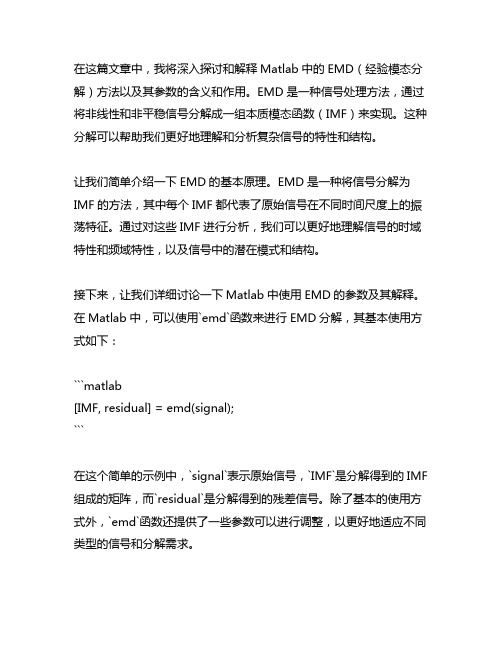
在这篇文章中,我将深入探讨和解释Matlab中的EMD(经验模态分解)方法以及其参数的含义和作用。
EMD是一种信号处理方法,通过将非线性和非平稳信号分解成一组本质模态函数(IMF)来实现。
这种分解可以帮助我们更好地理解和分析复杂信号的特性和结构。
让我们简单介绍一下EMD的基本原理。
EMD是一种将信号分解为IMF的方法,其中每个IMF都代表了原始信号在不同时间尺度上的振荡特征。
通过对这些IMF进行分析,我们可以更好地理解信号的时域特性和频域特性,以及信号中的潜在模式和结构。
接下来,让我们详细讨论一下Matlab中使用EMD的参数及其解释。
在Matlab中,可以使用`emd`函数来进行EMD分解,其基本使用方式如下:```matlab[IMF, residual] = emd(signal);```在这个简单的示例中,`signal`表示原始信号,`IMF`是分解得到的IMF 组成的矩阵,而`residual`是分解得到的残差信号。
除了基本的使用方式外,`emd`函数还提供了一些参数可以进行调整,以更好地适应不同类型的信号和分解需求。
第一个参数是`'MaxNumIMF'`,它代表了分解得到的IMF的最大数目。
通过调整这个参数,我们可以控制分解得到的IMF的数量,从而影响分解的精细程度和复杂度。
一般来说,如果原始信号比较复杂,我们可以适当增加这个参数的值,以获得更多的IMF来更好地描述信号的特性。
第二个参数是`'SiftRelativeTolerance'`,它代表了SIFT停止筛选的相对容忍度。
SIFT是EMD分解过程中的一种筛选方法,通过调整这个参数,我们可以控制SIFT筛选的精细程度和收敛速度。
一般来说,如果分解过程收敛速度较慢,我们可以适当增加这个参数的值来加快分解过程。
第三个参数是`'Interpolation'`,它代表了插值方法。
在信号长度不是2的N次幂时,需要对信号进行插值处理以适应EMD的要求。
【原创】matlab使用经验模式分解emd 对信号进行去噪数据分析报告论文(含代码数据)

咨询QQ:3025393450有问题百度搜索“”就可以了欢迎登陆官网:/datablogmatlab使用经验模式分解emd 对信号进行去噪数据分析报告来源:大数据部落| 有问题百度一下“”就可以了对于这个例子,考虑由具有明显频率变化的正弦波组成的非平稳连续信号。
手提钻的振动或烟花声是非平稳连续信号的例子。
以采样频率加载非平稳信号数据fs,并可视化混合正弦信号。
load('sinusoidalSignalExampleData.mat','X','fs');xlabel('Time(s)');咨询QQ:3025393450有问题百度搜索“”就可以了欢迎登陆官网:/datablog观察到混合信号包含具有不同幅度和频率值的正弦波。
为了创建希尔伯特谱图,您需要信号的IMF。
执行经验模式分解以计算信号的固有模式函数和残差。
由于信号不平滑,请指定' pchip'作为Interpolation方法。
[imf,residual,info] = emd(X,'Interpolation','pchip');目前的IMF | #Sift Iter | 相对Tol | 停止标准命中1 |2 | 0.026352 | SiftMaxRelativeTolerance2 | 2 | 0.0039573 | SiftMaxRelativeTolerance3 | 1 | 0.024838 | SiftMaxRelativeTolerance4 | 2 | 0.05929 | SiftMaxRelativeTolerance5 | 2 | 0.11317 | SiftMaxRelativeTolerance6 | 2 | 0.12599 | SiftMaxRelativeTolerance7 | 2 | 0.13802 | SiftMaxRelativeTolerance咨询QQ:3025393450有问题百度搜索“”就可以了欢迎登陆官网:/datablog8 | 3 | 0.15937 | SiftMaxRelativeTolerance9 | 2 | 0.15923 | SiftMaxRelativeTolerance分解停止是因为残留信号的极值数小于'MaxNumExtrema'。
emd经验模态分解matlab代码

emd经验模态分解matlab代码EMD (Empirical Mode Decomposition) 是一种用于信号分解和分析的方法,它将非线性和非平稳信号分解成一组称为本征模态函数(Intrinsic Mode Functions, IMF) 的成分。
本文将介绍如何使用MATLAB 实现 EMD,并利用经验模态分解分析一个示例信号。
我们需要了解 EMD 的基本原理。
EMD 是一种自适应的信号分解方法,它通过将信号分解为一组本征模态函数来描述信号的局部特征。
每个本征模态函数都具有不同的频率和幅度,且满足以下两个条件:在数据极值点的个数上或下一致,且在任意点上的平均值为零。
经过分解后,信号可以用这些本征模态函数的线性组合来表示。
在 MATLAB 中,我们可以使用 `emd` 函数实现 EMD。
首先,我们需要将要分解的信号保存为一个一维数组。
然后,我们可以使用以下代码进行信号的经验模态分解:```matlabimf = emd(signal);```其中,`signal` 是我们要分解的信号,`imf` 是一个包含所有本征模态函数的矩阵。
每一列对应一个本征模态函数,其中第一列是最高频率的本征模态函数,最后一列是最低频率的本征模态函数。
接下来,我们可以对信号和本征模态函数进行分析和可视化。
我们可以使用以下代码绘制原始信号和每个本征模态函数的图形:```matlabfigure;subplot(length(imf)+1,1,1);plot(signal);title('原始信号');for i = 1:length(imf)subplot(length(imf)+1,1,i+1);plot(imf(:,i));title(['IMF ' num2str(i)]);end```这段代码将原始信号和每个本征模态函数绘制在一个图形窗口中,每个图形都有一个相应的标题。
我们可以通过观察每个本征模态函数的频率、振幅和形状来分析信号的局部特征。
eemd的matlab代码

eemd的matlab代码EMD(Empirical Mode Decomposition)是一种基于自适应数据分解技术的信号处理方法,将数据分解成一系列本征模函数(EMD),然后进行频率分析和时频分析。
EMD的最大好处是在信号分解过程中不需要做任何先验假设或者预处理,同时分解的本征模态函数(IMF)是时频局部化的,因而可以很好地处理非线性和非平稳信号。
EMD方法在地震学、金融和医学等领域得到了广泛应用。
EMD的matlab代码实现:1. 打开matlab2. 打开编辑器3. 新建一个文件,命名为emd.m4. 输入以下代码:function [imf,residual]=emd(x)% EMD% Given signal x (1,n), return IMFs in rows of matrix IMF (max num IMFs= n-1) and residual in vector res.n=length(x);if n<3error('Input signal length must be greater than 3.');endh=hilbert(x);x=h.*conj(h);x=x-mean(x);r=x;k=1;while k<=12 && ~issparse(r)d=r;for i=1:nminx=min([d(1:i-1) Inf d(i+1:n)]);max1=max(d(1:i-1));max2=max(d(i+1:n));if minx==Infcontinueendif x(i)>=max1 && x(i)>=max2 && x(i)>=minx d(i)=0;endendIMF(k,:)=r-d;r=d;if all(abs(IMF(k,:)))<.1*eps*max(abs(x))IMF(k,:)=[];breakendk=k+1;endresidual=x-sum(IMF);residual=real(h).*sign(residual);imf=real(h).*sign(IMF);%5. 保存文件6. 在matlab命令窗口中输入emd(数据),即可进行EMD分解。
经验模态分解(EMD)在地球物理资料中的应用(附MATLAB程序)

经验模态分解(EMD)在地球物理资料中的应用(附MATLAB程序)摘要经验模态分解(EMD)是由Huang等人提出的一种新的分析非线性、非平稳信号的方法。
本文研究经验模态分解原理及其在地球物理资料中的应用。
首先研究经验模态分解的基本原理和算法,对地球物理资料(地震资料,重磁资料)进行EMD分解试验分析,然后研究基于...<P>摘 要<BR>经验模态分解(EMD)是由Huang等人提出的一种新的分析非线性、非平稳信号的方法。
本文研究经验模态分解原理及其在地球物理资料中的应用。
首先研究经验模态分解的基本原理和算法,对地球物理资料(地震资料,重磁资料)进行EMD分解试验分析,然后研究基于EMD的Hilbert变换原理及其在提取地震属性信息中的应用,对实际地震时间剖面和时间切片进行EMD时频分析试验。
<BR>本文的方法研究和数据试验分析表明:经EMD分解变换得到的IMF序列是直接从原始时序数据中分离出来的,事先无需确定分解阶次,能更好反映原始数据固有的物理特性,每阶IMF序列都代表了某种特定意义的频带信息;EMD分解获得的IMF序列具有稳态性,对IMF进行Hilbert变换,就可以得到单个固有模态函数的瞬时振幅、瞬时相位和瞬时频率,这些信息可以清楚的显示信号的时频特征;EMD分析方法用于分解地球物理资料和作时频分析是有效的。
<BR>关键词:经验模态分解;地球物理;Hilbert变换;固有模态函数;时频分析<BR> <BR>ABSTRACT<BR>Empirical Mode Decomposition(EMD), which was developed by huang, is a new method to analyse nonlinear and nonstationary signals. In this paper, we study the theory of EMD and its applications in handling geophysical data. Firstly, we introduce the theory and the Methodology about EMD ,then we will use this method to analyse the geophysical information, including the g ravity anomaly data and seism’s data. Based on the EMD, we will study the theory of the Hilbert transform, and then use it to obtain the images,from which we can deal with the seism’s slice by time- frequency analysis in order to distill the seism’s information. <p class='Omx379'></p> <BR>The studying of EMD and the data testing in this paper indicate: intrinsic mode functions(IMF) is comes from the original signal by the EMD, in this course, we need not fix on the Decomposition number and would not influenced by some men’s factors. Every intrinsic mode function stand for some given information and can reflect theintrinsic physical Information very well. Meantime, take the IMF for Hilbert transform, then we can get the IMF’ frequency and the amplitude, which can show the signal’s characteristics very clearly. So it is very useful to use the EMD to study the geophysical data.<BR>Key words: Empirical Mode Decomposition; geophysics; Hilbert transform; <BR>intrinsic mode function; time- frequency analysis <p class='Omx379'></p> </P><P>目前,信号处理[1]方法主要有傅立叶变换、小波变换等,这些方法在处理线性、平稳的信号时,具有简单、效率高等优点,然而,在实际的地球物理数据测量中,许多信号是非平稳的或非线性的,如果在处理这些信号时,仍假设数据是平稳或线性的,会使我们得到错误的分析结果,为了正确有效地分解非平稳信号,本文研究一种新的方法,即经验模态分解(EMD) [2],该方法是由Huang等人提出的一种新的分析非线性、非平稳信号的方法。
emd分解matlab程序

emd分解matlab程序EMD(Empirical Mode Decomposition)是一种信号处理方法,用于将非线性和非平稳信号分解为一组称为本征模态函数(Intrinsic Mode Functions,IMFs)的振动模式。
本文将介绍如何使用MATLAB编写EMD程序,并对其进行详细解释。
首先,我们需要定义一个函数来实现EMD分解。
以下是一个基本的EMD函数的框架:```matlabfunction [IMFs, residual] = emd(signal)% 初始化IMFs和残差IMFs = [];residual = signal;% 循环分解信号直到残差为0或者只剩下一个IMFwhile (is_imf(residual))% 计算当前信号的极值点extrema = find_extrema(residual);% 计算当前信号的上包络线和下包络线upper_envelope = upper_envelope_line(residual, extrema);lower_envelope = lower_envelope_line(residual, extrema);% 计算当前信号的均值mean_value = (upper_envelope + lower_envelope) / 2;% 计算当前信号的IMFimf = residual - mean_value;% 将当前IMF添加到IMFs列表中IMFs = [IMFs, imf];% 更新残差为当前信号减去当前IMFresidual = residual - imf;endend```上述代码中,`is_imf`函数用于判断一个信号是否为IMF,`find_extrema`函数用于找到信号的极值点,`upper_envelope_line`函数和`lower_envelope_line`函数用于计算信号的上包络线和下包络线。
基于EMD的包络谱进行故障诊断matlab程序实例

基于EMD的包络谱进⾏故障诊断matlab程序实例刚开始接触滚动轴承故障诊断通常都是⼀头雾⽔。
其实只要按部就班就可以了。
滚动轴承故障诊断分为数据采集、数据处理和故障辨识(或故障预测)。
⼀接到故障诊断这个课题,你⾸先要明⽩,这三个步骤中,你想搞哪块。
⼀般在其中⼀块有突破,基本上硕⼠就可以毕业了。
下⾯介绍的是⽤EMD和包络解调进⾏数据处理,然后⼈⼯进⾏故障辨识。
matlab程序:(内圈故障、外圈故障)%转速: 1750转/分%转频:29.16(29)%采样率:12K%轴承型号:6205%inner ring:5.4152%outer ring:3.5848%ge train:0.39828%rolling element:4.7135%外圈故障:104.57%内圈故障:157.94(158)%滚动体双故障:137.49%滚动体单故障:68.75%保持架外圈故障:11.62(12)【外圈静⽌,内圈转动】%-----------------%转速1750的6025轴承的深度7的内圈点蚀故障%驱动计数端的内圈故障,故障明显,基于EMD的包络解调有效%风扇计数端的内圈故障,故障效果不好,基于EMD的包络解调不是很有效%基础计数端的内圈故障,故障效果不好,基于EMD的包络解调⽆效,只能看到转频,故障频率不明显load 1750I7.mat;%内圈故障数据x=X107_DE_time;%驱动计数段的内圈故障fs=12000;%采样率N=10240;%采样点数(100倍)M=0;%采样数据段的起始位置n=M:N-1;t=n/fs;%信号时间序列X=X107_DE_time(1:N);%装载 驱动计数端的内圈故障数据%X=X107_FE_time(1:N);%装载 风扇计数端的内圈故障数据%X=X107_BA_time(1:N);%装载 基础计数端的内圈故障数据%X=X107_DE_time(1:N)-X107_BA_time(1:N);y=X’;%信号幅值序列k_in=kurtosis(y);%峭度系数,正常轴承为3左右figure;%画原始信号时域和频域图subplot(211);plot(t,y);title(‘原始信号时域波形’);subplot(212);hua_fft1(y,fs);title(‘原始信号频谱’);figure;%原始信号的包络谱subplot(211);hua_baoluo1(y,fs,1);title(‘原始信号包络谱’);subplot(212);hua_baoluo1(y,fs,1,500);title(‘原始信号部分频段包络谱’);imf=emd1(y);%经验模态分解figure;%前三个IMF分量subplot(311);plot(t,imf(1,:));title(‘IMF1时域波形图’);subplot(312);plot(t,imf(2,:));title(‘IMF2时域波形图’);subplot(313);plot(t,imf(3,:));title(‘IMF3时域波形图’);figure;%前三个IMF分量频谱subplot(311);hua_fft(imf(1,:),fs,1);title(‘IMF1频谱’);subplot(312);hua_fft(imf(2,:),fs,1);title(‘IMF2频谱’);subplot(313);hua_fft(imf(3,:),fs,1);title(‘IMF3频谱’);figure;%前三个IMF分量选择频段内的包络谱xf1=0;%需要查看的包络谱频率段起点频率xf2=1000;%需要查看的包络谱频率段终⽌频率subplot(311);hua_baol(imf(1,:),fs,1,xf1,xf2);title(‘IMF1包络谱’);subplot(312);hua_baol(imf(2,:),fs,1,xf1,xf2);title(‘IMF2包络谱’);subplot(313);hua_baol(imf(3,:),fs,1,xf1,xf2);title(‘IMF3包络谱’);。
EMD算法的matlab程序介绍
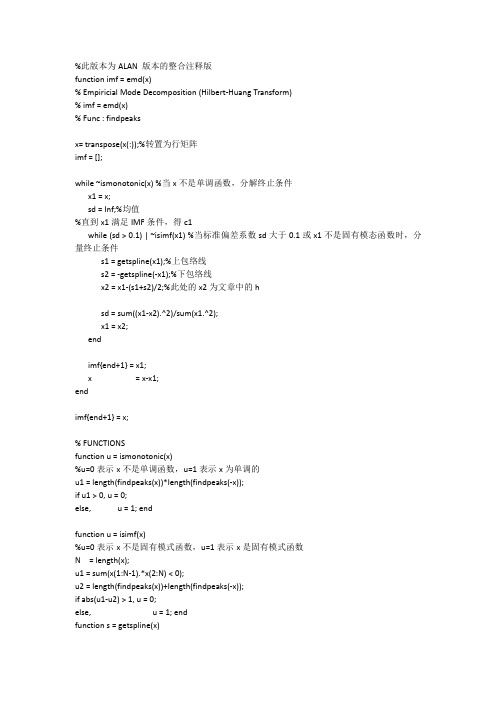
%此版本为ALAN版本的整合注释版function imf=emd(x)%Empiricial Mode Decomposition(Hilbert-Huang Transform)%imf=emd(x)%Func:findpeaksx=transpose(x(:));%转置为行矩阵imf=[];while~ismonotonic(x)%当x不是单调函数,分解终止条件x1=x;sd=Inf;%均值%直到x1满足IMF条件,得c1while(sd>0.1)|~isimf(x1)%当标准偏差系数sd大于0.1或x1不是固有模态函数时,分量终止条件s1=getspline(x1);%上包络线s2=-getspline(-x1);%下包络线x2=x1-(s1+s2)/2;%此处的x2为文章中的hsd=sum((x1-x2).^2)/sum(x1.^2);x1=x2;endimf{end+1}=x1;x=x-x1;endimf{end+1}=x;%FUNCTIONSfunction u=ismonotonic(x)%u=0表示x不是单调函数,u=1表示x为单调的u1=length(findpeaks(x))*length(findpeaks(-x));if u1>0,u=0;else,u=1;endfunction u=isimf(x)%u=0表示x不是固有模式函数,u=1表示x是固有模式函数N=length(x);u1=sum(x(1:N-1).*x(2:N)<0);u2=length(findpeaks(x))+length(findpeaks(-x));if abs(u1-u2)>1,u=0;else,u=1;endfunction s=getspline(x)%三次样条函数拟合成元数据包络线N=length(x);p=findpeaks(x);s=spline([0p N+1],[0x(p)0],1:N);---------------------------------------------------------------------------------------------------------------------------------------------------------------function n=findpeaks(x)%Find peaks.找到极值,n为极值点所在位置%n=findpeaks(x)n=find(diff(diff(x)>0)<0);u=find(x(n+1)>x(n));n(u)=n(u)+1;----------------------------------------------------------------------------------------------------------------------------------------------------------------------------------function plot_hht00(x,Ts)%双边带调幅信号的EMD分解%Plot the HHT.%plot_hht(x,Ts)%%::Syntax%The array(列)x is the input signal and Ts is the sampling period(取样周期). %Example on use:[x,Fs]=wavread('Hum.wav');%plot_hht(x(1:6000),1/Fs);%Func:emd%Get HHT.clear all;close all;Ts=0.0005;t=0:Ts:10;%采样率2000HZ%调幅信号%x=sin(2*pi*t).*sin(40*pi*t);x=sin(2*pi*t);s1=getspline(x);%上包络线s2=-getspline(-x);%上包络线x1=(s1+s2)/2;%此处的x2为文章中的hfigure;plot(t,x);xlabel('Time'),ylabel('Amplitude');title('双边带调幅信号');hold on;plot(t,s1,'-r');plot(t,s2,'-r');plot(t,x1,'g');imf=emd(x);for k=1:length(imf)b(k)=sum(imf{k}.*imf{k});th=angle(hilbert(imf{k}));d{k}=diff(th)/Ts/(2*pi);end[u,v]=sort(-b);b=1-b/max(b);%Set time-frequency plots.N=length(x);c=linspace(0,(N-2)*Ts,N-1);%figure;for k=v(1:2)plot(c,d{k},'k.','Color',b([k k k]),'MarkerSize',3);hold on;set(gca,'FontSize',8,'XLim',[0c(end)],'YLim',[050]);%设置x、y轴句柄xlabel('Time'),ylabel('Frequency');title('原信号时频图');end%Set IMF plots.M=length(imf);N=length(x);c=linspace(0,(N-1)*Ts,N);for k1=0:4:M-1figurefor k2=1:min(4,M-k1),subplot(4,1,k2),plot(c,imf{k1+k2});set(gca,'FontSize',8,'XLim',[0c(end)]);title('EMD分解结果');endxlabel('Time');end。
matlab使用经验模式分解emd 对信号进行去噪数据

咨询QQ:3025393450有问题到百度搜索“大数据部落”就可以了欢迎登陆官网:/datablogmatlab使用经验模式分解emd 对信号进行去噪数据对于这个例子,考虑由具有明显频率变化的正弦波组成的非平稳连续信号。
手提钻的振动和烟花声是非平稳连续信号的例子。
以采样频率加载非平稳信号数据fs,并可视化混合正弦信号。
load('sinusoidalSignalExampleData.mat','X','fs')t = (0:length(X)-1)/fs;plot(t,X)xlabel('Time(s)')咨询QQ:3025393450有问题到百度搜索“大数据部落”就可以了欢迎登陆官网:/datablog混合信号包含具有不同幅度和频率值的正弦波。
要创建希尔伯特谱图,您需要信号的固有模式函数(IMF)。
执行经验模式分解以计算信号的IMF和残差。
由于信号不平滑,请指定' pchip'作为Interpolation方法。
[imf,residual,info] = emd(X,'Interpolation','pchip');Current IMF | #Sift Iter | Relative Tol | Stop Criterion Hit1 |2 | 0.026352 | SiftMaxRelativeTolerance2 | 2 | 0.0039573 | SiftMaxRelativeTolerance3 | 1 | 0.024838 | SiftMaxRelativeTolerance4 | 2 | 0.05929 | SiftMaxRelativeTolerance5 | 2 | 0.11317 | SiftMaxRelativeTolerance6 | 2 | 0.12599 | SiftMaxRelativeTolerance7 | 2 | 0.13802 | SiftMaxRelativeTolerance咨询QQ:3025393450有问题到百度搜索“大数据部落”就可以了欢迎登陆官网:/datablog8 | 3 | 0.15937 | SiftMaxRelativeTolerance9 | 2 | 0.15923 | SiftMaxRelativeToleranceThe decomposition stopped because the number of extrema of the residual signal is less than 'MaxNumExtrema'.在命令窗口中生成的表格指示每个生成的IMF的筛选迭代次数,相对容差和筛选停止标准。
emd经验模态分解matlab代码
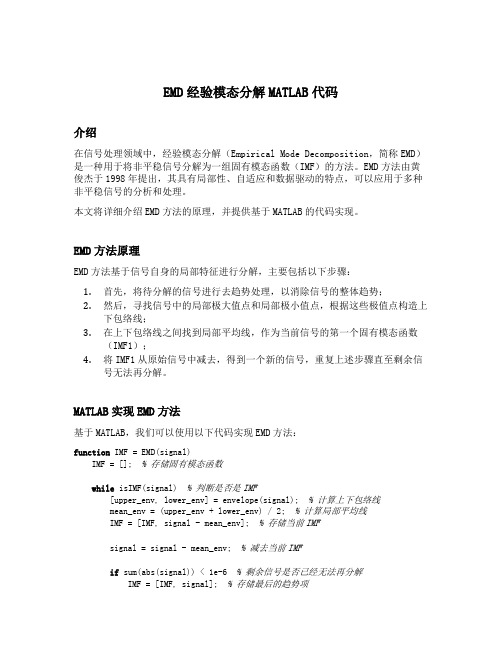
EMD经验模态分解MATLAB代码介绍在信号处理领域中,经验模态分解(Empirical Mode Decomposition,简称EMD)是一种用于将非平稳信号分解为一组固有模态函数(IMF)的方法。
EMD方法由黄俊杰于1998年提出,其具有局部性、自适应和数据驱动的特点,可以应用于多种非平稳信号的分析和处理。
本文将详细介绍EMD方法的原理,并提供基于MATLAB的代码实现。
EMD方法原理EMD方法基于信号自身的局部特征进行分解,主要包括以下步骤:1.首先,将待分解的信号进行去趋势处理,以消除信号的整体趋势;2.然后,寻找信号中的局部极大值点和局部极小值点,根据这些极值点构造上下包络线;3.在上下包络线之间找到局部平均线,作为当前信号的第一个固有模态函数(IMF1);4.将IMF1从原始信号中减去,得到一个新的信号,重复上述步骤直至剩余信号无法再分解。
MATLAB实现EMD方法基于MATLAB,我们可以使用以下代码实现EMD方法:function IMF = EMD(signal)IMF = []; % 存储固有模态函数while isIMF(signal) % 判断是否是IMF[upper_env, lower_env] = envelope(signal); % 计算上下包络线mean_env = (upper_env + lower_env) / 2; % 计算局部平均线IMF = [IMF, signal - mean_env]; % 存储当前IMFsignal = signal - mean_env; % 减去当前IMFif sum(abs(signal)) < 1e-6 % 剩余信号是否已经无法再分解IMF = [IMF, signal]; % 存储最后的趋势项break;endendendfunction flag = isIMF(signal)min_num = 3; % 判断是否是IMF所需的极大值和极小值点的最小数量max_num = 7; % 判断是否是IMF所需的过零点的最大数量extrema_num = length(find(diff(gradient(signal)) >= 0)); % 计算极大值和极小值点的数量zero_num = length(find(signal(1:end-1) .* signal(2:end) < 0)); % 计算过零点的数量flag = (extrema_num >= min_num && extrema_num <= max_num && zero_num == 0); % 判断是否是IMFend使用示例下面我们使用一个示例信号来演示EMD方法的使用:t = linspace(0, 1, 1000);signal = sin(20 * t.^2) + cos(10 * t.^3); % 待分解信号IMF = EMD(signal); % 进行信号分解figure;subplot(length(IMF) + 1, 1, 1);plot(t, signal);title('原始信号');for i = 1:length(IMF)subplot(length(IMF) + 1, 1, i + 1);plot(t, IMF(i, :));title(['IMF', num2str(i)]);end运行以上代码,我们可以得到原始信号及其分解后的IMF部分如下图所示:结论本文介绍了EMD经验模态分解方法的原理,并提供了基于MATLAB的代码实现。
imf 频率曲线 matlab
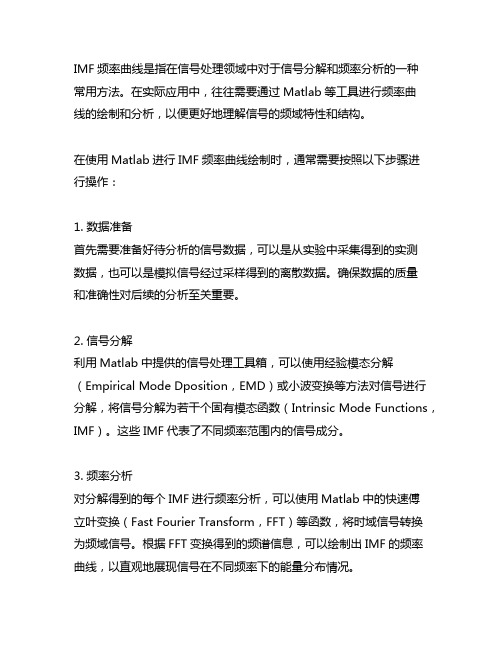
IMF频率曲线是指在信号处理领域中对于信号分解和频率分析的一种常用方法。
在实际应用中,往往需要通过Matlab等工具进行频率曲线的绘制和分析,以便更好地理解信号的频域特性和结构。
在使用Matlab进行IMF频率曲线绘制时,通常需要按照以下步骤进行操作:1. 数据准备首先需要准备好待分析的信号数据,可以是从实验中采集得到的实测数据,也可以是模拟信号经过采样得到的离散数据。
确保数据的质量和准确性对后续的分析至关重要。
2. 信号分解利用Matlab中提供的信号处理工具箱,可以使用经验模态分解(Empirical Mode Dposition,EMD)或小波变换等方法对信号进行分解,将信号分解为若干个固有模态函数(Intrinsic Mode Functions,IMF)。
这些IMF代表了不同频率范围内的信号成分。
3. 频率分析对分解得到的每个IMF进行频率分析,可以使用Matlab中的快速傅立叶变换(Fast Fourier Transform,FFT)等函数,将时域信号转换为频域信号。
根据FFT变换得到的频谱信息,可以绘制出IMF的频率曲线,以直观地展现信号在不同频率下的能量分布情况。
4. 曲线绘制使用Matlab中的绘图函数,如plot函数或stem函数,根据频率分析得到的结果绘制出IMF频率曲线。
通过合理的坐标轴设置和标注,可以清晰地展示出每个IMF在频率域上的特性,帮助分析人员理解信号的频域结构。
5. 结果分析根据绘制得到的IMF频率曲线,可以进行进一步的结果分析和解释。
可以观察不同IMF在频率上的分布情况,判断信号中的主要频率成分和能量分布规律,为后续的信号处理和特征提取提供参考依据。
IMF频率曲线的绘制和分析在信号处理和振动分析等领域具有重要的应用价值,可以帮助工程技术人员深入理解信号的频域特性,从而更好地进行信号处理、故障诊断和结构健康监测等工作。
利用Matlab 等工具进行频率曲线分析,既方便快捷又可靠准确,为工程领域的科研和实际工作提供了有力的支持。
EMD的matlab程序

clear;clc;tic;N=512;fs=512;t=0:1/fs:(N-1)/fs;xinhao=sin(2*pi*50*t)+0.3*sin(5.5*pi*50*t);plot(xinhao);title('');xlabel('');ylabel('');imf=sigmatching_emd(xinhao,[0.02,0.5,0.05],0);plot_emd_result(imf);tocfunction imf=sigmatching_emd(x,stop_condition,display)if nargin<3display=0;endif nargin<2;stop_condition=[0.05,0.5,0.05];display=0;endr=x;k=1;while ~stop_EMD(r);m=r;[stop_sift,moyenne]=stop_sifting(m,stop_condition,display);if (max(abs(m)))<(1e-16)*(max(abs(x)))breakendwhile ~stop_siftm=m-moyenne;[stop_sift,moyenne]=stop_sifting(m,stop_condition,display);endimf(k,:)=m;k=k+1;r=r-m;endimf(k,:)=r;end%--------------------------------------------------------------------------function stop=stop_EMD(r)[indmin indmax]=extr(r);ner=length(indmin)+length(indmax);stop=ner<3;end%--------------------------------------------------------------------------function [envmoy,nem,nzm,amp]=compute_mean(m,t,display) NBSYM=2;[indmin,indmax,indzer]=extr(m);nzm=length(indzer);nem=length(indmin)+length(indmax);if display==1;figuresubplot(3,1,1)plot(m);subplot(3,1,2)box onhold onplot(m);plot(indmin,m(indmin),'r.');plot(indmax,m(indmax),'c.');hold offend[lz,rz,sig]=ppyt(m);[indmin,indmax]=extr(sig);[tmin,tmax,mmin,mmax]=boundary_conditions_emd(indmin,indmax,1:length(sig),sig,sig,NBSYM); envmin=interp1(tmin,mmin,[(lz+1):(length(t)+lz)],'spline');envmax=interp1(tmax,mmax,[(lz+1):(length(t)+lz)],'spline');envmoy=(envmin+envmax)/2;amp=mean(abs(envmax-envmin),1)/2;if display==1;subplot(3,1,3)box onhold onplot(m);plot(envmin,'r-');plot(envmax,'c-');plot(envmoy,'y-');hold offendend%--------------------------------------------------------------------------function [stop,envmoy]=stop_sifting(m,stop_condition,display)sd=stop_condition(1);sd2=stop_condition(2);tol=stop_condition(3);t=1:length(m);try[envmoy,nem,nzm,amp]=compute_mean(m,t,display);sx=abs(envmoy)./amp;stop=~((mean(sx>sd)>tol|any(sx>sd2))&(all(nem>2)));stop=stop&&~(abs(nzm-nem)>1);catchstop=1;envmoy=zeros(1,length(m));endendfunction [zjsy,begin]=sig_match(sig)[indmax indmin]=extr(sig);l=length(sig);lmax=length(indmax);lmin=length(indmin);if lmax>=lmink=lmin;elsek=lmax;endfor i=1:(k-1)tx(i)=(indmax(1)*indmin(i+1)-indmin(1)*indmax(i+1))/(indmax(1)-indmin(1));endn=1:l;y=interp1(n,sig,tx,'linear');for i=1:length(y)e(i)=abs(sig(indmax(i+1))-sig(indmax(1)))+abs(sig(indmin(i+1))-sig(indmin(1)))+abs(y(i)-sig(1)); end[ea,indea]=sort(e);inde=indea(1);zjsy=tx(inde)-1;zjsy=floor(zjsy);if inde<=1begin=1;elsebegin=tx(inde-1);endbegin=floor(begin);endfunction [lz,rz,sigu]=ppyt(sig)lz=sig_match(sig);l=length(sig);sig1 = fliplr(sig);rz=sig_match(sig1);sig2=[sig1(1:rz),sig1];sig3 = fliplr(sig2);sigu=[sig(1:lz),sig3];endfunction plot_emd_result(imf)[m n]=size(imf);figuret=1:n;for k=1:m-1subplot(m,1,k);biaoqian(k)=gca;plot(t,imf(k,:))xlabel('t')ylabel(['imf',int2str(k)])set(gca,'XLim',[0,n])endtitle(biaoqian(1),'EMD·Ö½â½á¹û')subplot(m,1,m); plot(t,imf(m,:),'r') set(gca,'XLim',[0,n]) ylabel('r')xlabel('t')。
- 1、下载文档前请自行甄别文档内容的完整性,平台不提供额外的编辑、内容补充、找答案等附加服务。
- 2、"仅部分预览"的文档,不可在线预览部分如存在完整性等问题,可反馈申请退款(可完整预览的文档不适用该条件!)。
- 3、如文档侵犯您的权益,请联系客服反馈,我们会尽快为您处理(人工客服工作时间:9:00-18:30)。
%此版本为ALAN 版本的整合注释版
function imf = emd(x)
% Empiricial Mode Decomposition (Hilbert-Huang Transform)
% imf = emd(x)
% Func : findpeaks
x= transpose(x(:));%转置为行矩阵
imf = [];
while ~ismonotonic(x) %当x不是单调函数,分解终止条件
x1 = x;
sd = Inf;%均值
%直到x1满足IMF条件,得c1
while (sd > 0.1) | ~isimf(x1) %当标准偏差系数sd大于0.1或x1不是固有模态函数时,分量终止条件
s1 = getspline(x1);%上包络线
s2 = -getspline(-x1);%下包络线
x2 = x1-(s1+s2)/2;%此处的x2为文章中的h
sd = sum((x1-x2).^2)/sum(x1.^2);
x1 = x2;
end
imf{end+1} = x1;
x = x-x1;
end
imf{end+1} = x;
% FUNCTIONS
function u = ismonotonic(x)
%u=0表示x不是单调函数,u=1表示x为单调的
u1 = length(findpeaks(x))*length(findpeaks(-x));
if u1 > 0, u = 0;
else, u = 1; end
function u = isimf(x)
%u=0表示x不是固有模式函数,u=1表示x是固有模式函数
N = length(x);
u1 = sum(x(1:N-1).*x(2:N) < 0);
u2 = length(findpeaks(x))+length(findpeaks(-x));
if abs(u1-u2) > 1, u = 0;
else, u = 1; end
function s = getspline(x)
%三次样条函数拟合成元数据包络线
N = length(x);
p = findpeaks(x);
s = spline([0 p N+1],[0 x(p) 0],1:N);
-------------------------------------------------------------------------------
--------------------------------------------------------------------------------
function n = findpeaks(x)
% Find peaks.找到极值,n为极值点所在位置
% n = findpeaks(x)
n = find(diff(diff(x) > 0) < 0);
u = find(x(n+1) > x(n));
n(u) = n(u)+1;
------------------------------------------------------------------------------------------
----------------------------------------------------------------------------------------
function plot_hht00(x,Ts)
% 双边带调幅信号的EMD分解
% Plot the HHT.
% plot_hht(x,Ts)
%
% :: Syntax
% The array(列)x is the input signal and Ts is the sampling period(取样周期). % Example on use: [x,Fs] = wavread('Hum.wav');
% plot_hht(x(1:6000),1/Fs);
% Func : emd
% Get HHT.
clear all;
close all;
Ts=0.0005;
t=0:Ts:10; % 采样率2000HZ
% 调幅信号
%x=sin(2*pi*t).*sin(40*pi*t);
x=sin(2*pi*t);
s1 = getspline(x);%上包络线
s2 = -getspline(-x);%上包络线
x1 = (s1+s2)/2;%此处的x2为文章中的h
figure;
plot(t,x);xlabel('Time'), ylabel('Amplitude');title('双边带调幅信号');hold on;
plot(t,s1,'-r');
plot(t,s2,'-r');
plot(t,x1,'g');
imf = emd(x);
for k = 1:length(imf)
b(k) = sum(imf{k}.*imf{k});
th = angle(hilbert(imf{k}));
d{k} = diff(th)/Ts/(2*pi);
end
[u,v] = sort(-b);
b = 1-b/max(b);
% Set time-frequency plots.
N = length(x);
c = linspace(0,(N-2)*Ts,N-1);
%
figure;
for k = v(1:2)
plot(c,d{k},'k.','Color',b([k k k]),'MarkerSize',3); hold on;
set(gca,'FontSize',8,'XLim',[0 c(end)],'YLim',[0 50]);%设置x、y轴句柄xlabel('Time'), ylabel('Frequency');title('原信号时频图');
end
% Set IMF plots.
M = length(imf);
N = length(x);
c = linspace(0,(N-1)*Ts,N);
for k1 = 0:4:M-1
figure
for k2 = 1:min(4,M-k1),
subplot(4,1,k2),
plot(c,imf{k1+k2});
set(gca,'FontSize',8,'XLim',[0 c(end)]);
title('EMD分解结果');
end
xlabel('Time');
end。
